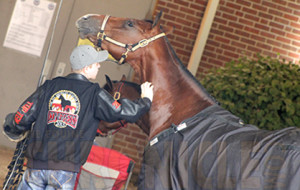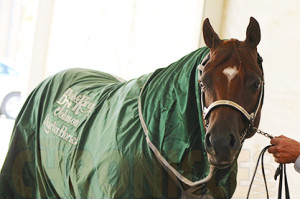Are You Ready For Winter? Part 5- Keeping Horses Fit During the Off Season
By: Megan Arszman
The colder temperatures of winter often mean a decline in physical activity—for both human and horse. Freezing temperatures combined with snow or icy footing is not inviting or conducive for a workout, leaving northern horse owners envious of those based in the southern portion of the United States. Still, you don’t want your horse to get flabby and lose all the conditioning you worked so hard for during the summer… so what should you do?
Warming Up
Including a warm up and stretching routine into your horse’s exercise program is even more crucial when the temperatures drop. Doing so allows the blood to start flowing and helps stiff muscles and joints loosen up, which can prevent injury as well as prolong a show career.
Warm up sessions should last 10-20 minutes. Start by having your horse walk on a loose rein, which allows him to get everything moving. You want your warm up movements to be slow and easy; no quick turns or sudden changes at this point. After about five minutes of walking, you can begin working on stretching with smaller circles by flexing the neck in both directions, shoulders in/out, two-tracking, stopping, and (slowly) backing, etc. Then, you can move up to the jog and repeat the process.
Moving from the frigid winter temperatures of Indiana down to a milder Texas climate might seem like it would make winter riding easier. However, Rose Snyder of Snyder Performance Horses points out that’s not exactly the case. Her family’s farm in Indiana has an indoor arena, while their farm in Texas currently doesn’t. “I actually think I have to deal with the cold more here, just because we don’t have an indoor arena like our parents do [in Indiana,]” she laughs. “I pony my horses a lot before I ride them, especially at the trot. I’ll usually throw a saddle on them before I pony them; that really helps warm their backs up.”
After a proper warm up, your horse should be ready for whatever type of workout you’re looking to perform—either maintenance or more conditioning. If you’re riding in an indoor arena, you should be able to work like normal. However, outdoor riding might mean taking it easy on frozen ground or having to deal with wind chill. Frozen ground can result in sole bruising if your horse is barefoot, especially if your horse has a thin sole.
Cooling Down
Cool downs are just as important as warm ups. A proper cool down should take 10-15 minutes. Going back to walking on a loose rein will allow your horse to slow his heart rate and breathing. Easy, light stretches will help keep him limber after the ride.
If your horse is sweaty, you’ll want to consider hand walking while using a Polarfleece blanket to help fend off the chill. You don’t want your horse to cool off too quickly, but you want his skin to be dry to the touch before the end of the cool down.
“Coolers are a must after a hard workout,” Snyder says. “They can also be used pre-workout to help warm up muscles. Sometimes, I’ll saddle all my horses and tie them in their stalls with a cooler thrown over the saddle while they wait for their workouts.”
If you’re planning to blanket your horse following the ride, be sure he is completely dry. Trapped moisture under a blanket can give a horse a chill. Some experts recommend giving your horse a good brushing, especially with a curry comb, to help fluff up the hair after he’s completely dry, especially if you’re not planning to blanket.
Using Technology
The staff at The Sanctuary Equine Sports Therapy and Rehabilitation Center in Ocala, Fla., sees plenty of competitors who come in especially to use their equipment during the winter season. General manager Brenda McDuffee confirms this is their busiest time of year.
Sport horses, hunter/jumpers, and dressage horses might benefit from using a water treadmill. “It’s a great way to do strength training with less concussion,” McDuffee explains. “It also works the horse in a way that encourages strengthening of core muscles and developing stronger backs and hind quarters.”
Other options at The Sanctuary include using the swimming pool for cardio sessions and magnawave-electromagnetic pulse therapy. “[This therapy is used] as an all-over body treatment to relieve sore muscles, stresses, and strains,” McDuffee says.
“One thing I like to use to really help warm up horses is an Equivibe,” Snyder says. “It’s a vibration therapy plate that the horses stand on. It’s great for horses that are recovering from an injury but can also help warm them up before a workout.”
With proper warm up and cool down sessions, and keeping in mind changes in winter footing, you can still keep your horse in shape and be ready to hit the show circuit when spring comes around.












